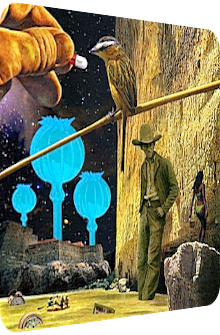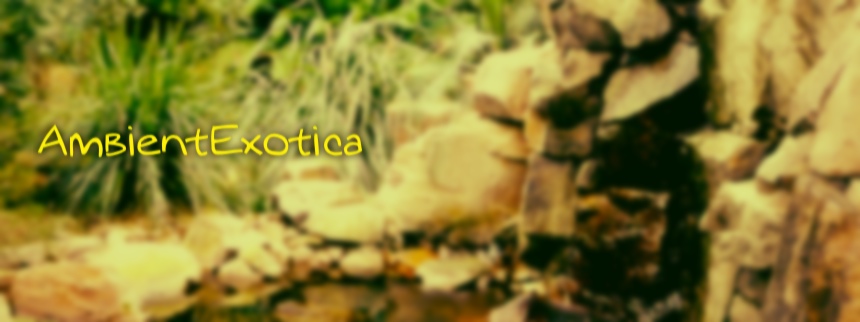
Solipsism & Nacht Plank
Opiate Odyssey
2013
The …txt label is resurrected and celebrates its relaunch with a special piece of enchantment: Craig Murphy‘s and …txt owner Lee Norris’ Opiate Odyssey, a six-track record released as a limited run of 50 CD's and as a download version in August 2013. The British duo has worked together previously and can look back to a wide and diverse discography, with Murphy using the name Solipsism while Norris works under the monikers of Norken, The Ashes Of Piemonte, Metamatics and Nacht Plank, among others. Opiate Odyssey is a superbly dreamy journey that feels much less than an odyssey rather than a soothing drift through cosmic caverns, aural antra and celestial cathedrals. Even though these architectural particularities are nowhere mentioned in the press text or by the duo, it feels to me as if all aspects of the long journey take place in innermost sanctuaries and vaulted places. All pieces have in common that they are progressively pushing forward to a more elysian state. The faux-erudite phrase from a reviewer’s sentence-building set comes to mind which says: “The songs are developing” or “they are growing on me,” but here in this case, they are actually growing and nurturing both their effulgence and transitional layer entanglement. The voluminosity becomes larger, everything feels exceptionally puffy. It is not clear which particular hardware or gadgets the prolific producers have used. To me, this is always important in regard to one reoccurring error on my side only: I often mix up synths with guitars and vice versa due to the stupendous possibilities of camouflaging the truthful origins of instruments nowadays, so when I write that Opiate Odyssey is a delightfully synth-based work, I might be proven wrong in the end. In order to prevent this for the moment, I simply call it a synth-oid album, with an even better coinage about to follow in the latter parts of this review. But first, here is a more meticulous look at all six tracks.
The gateway construction is called Opiate Scope On, and considering the designedly weird and portentous titles the duo has in store for the listener, the linguistic structure almost feels like a demand sans exclamation mark. In the given endemic circumstances, Opiate Scope On is an archetypical prime example of a cautiously widened pool of patterns and surfaces in the very legato style that is so essential for Drone music. Right from the get-go and during the fade-in phase, the golden luminosity of the delicately somnolent synth runlets is already firmly in place, but still alloyed with abyssal bass tendrils. Encapsulated in a quasi-ecclesiastic shelter, Solipsism and Nacht Plank let the beguiling fluxion oscillate between a cherubic incandescence and calcined cloudlets, but the tendency and eventual task become increasingly clear: lifting the aforementioned veil, curiously enough by both stressing the pristine clarity and bolstering the wadded diffusion. The interim result merges silkened New Age-like Chinese gongs and spectral dark matter protuberances with Geiger counter-resembling bonfire crackles of the soothing kind, all the while the rich alluvial riverbeds are still floating in close proximity. Opiate Scope On continues to retain its dualistically blurred-granular physiognomy of a mountainous den. Airflows of thermal heat waft in the distance, the reverberation of the gongs is potentially gelid, but harmoniously embedded in the erbaceous strata. Neglecting esotericism by only hinting at it in the far-away nullspace, Murphy’s and Norris’ anacrusis of their album is an eminently mellow one.
Mellowness resides in True Hewn Wren as well, but even though the short-winged songbird is transparently mentioned in the title, its habitat is no outdoor coppice. Solipsism and Nacht Plank prefer to envision a wondrous crystal cavity of sparkling scintillae, whitewashed synth helixes and terraqueous vesicles. An adumbrated straight bassline flows into a streamlined bass fundament onto whose state of floatation gently buzzing coils and mauve-tinted polyphonic synth gyres are grafted. Everything seems to float and glint, genteel paroxysms burst and cauterize, and it is during this liquid-aeriform state that an unexpected discovery can be made: despite True Hewn Wren being a proper Drone track, its hollowed glissando structures allow interstitial alcoves through which the afterglow of the rich synth fireflies is able to radiate out. The fissured, lacunar architecture augments the loftiness while allowing the maintenance of the spheroidal depth of field. A Detroit track without beats, True Hewn Wren is an acratothermal site of wonder and thus a great counterpart to the electro-acoustic Ambient movement which reigns over this decade. The following Odyssey’s Manic Kit is just a few seconds shy of ten minutes, but all the more keen on a piercing intensity. Even during the opening phase, the synth beam comprises a vigorous acridity, an iridescent incisiveness that serves as the main aorta of all other sinews that are about to be placed around it. Distantly brazen cloud protrusions become enmeshed with additional prolonged flute-like serpentines and glitzy pulses. The almost bedazzling climax is reached in the middle when the brightness blazes through the epicurean superstructure. After this revelation, Murphy and Norris give the arrangement room to breathe via softened synth monotonies; they serve as the base for globs, glints and sustained polar lights of all kinds. It is this very light which then fades out into the distance.
The final two tracks are of the long-winded kinds and unexpectedly less polymorphous than the preceding material. The intrinsic intermixture of synth washes and pulsating shards remains coherent, although the various blebs and specks do not appear in an overtly sparkling, coruscating fashion anymore. They remain under the radar, so to speak, an adage I do not use out of the blue, for the duo’s Radars Can’t Detect Her inspired this notion, and strongly so. This is the softest, haziest ode to a Gaussian blur the British sound wizards ever came up with. Akin to the opener Opiate Scope On, the inarticulate and unsharp state is celebrated and ennobled with the inclusion of various textures and short wind gusts. Despite the purposeful monotony, there is a sense of melodious structures embedded, as half-tone steps, gyrating swooshes and insinuated synth pad sequences conflate with each other. The deep bass stratum serves as the fertile ground for rhizomatic embellishments and theremin-oid reciprocations. During all these states, Radars Can’t Detect Her is indeed adamantly orderly, but its final minutes unleash cavalcades of bliss, voluminous overtones and sumptuous cornucopias. There is no way that even the most lackluster DIY radar could not spot these beautiful shapes! The finale is called Crlaegi and is a piece of 26+ minutes. This one resembles a vitreous Gaelic cathedral high above the clouds. The large amount of reverb is not noticeable at the beginning, for reverberations of deep frequencies are much harder to detect, but rest assured that these effects are, unknowingly to most listeners, distilled by the brain; the result is a large wideness which is then properly awash with light in the form of pipe organ-resembling streams, synth strings of the acroamatic and embracing kinds as well as amicable yet enigmatic showers of synthetic granularity. The underlying hiss is magnificent and broadens the perceived posh of the textures without ridiculing their erudite erethism. Crlaegi is the apotheosis to a süperb sÿnthorama.
And there’s the signature word I use every so often when I come across the more synth-fueled Ambient releases of today: sÿnthorama. In this regard, Opiate Odyssey is a revelation, a wonderful amalgamation of various textures, droning structures and girdling oscillations. No obvious guitar is in sight or ever used, and if it is, the hyper-processed embodiment does not reveal the characteristic traits. I am particularly fond of both the wideness and the little clefts of this Drone album, the latter of which are definitely no necessity or stylistic must-have in terms of this subgenre, but since Craig Murphy and Lee Norris allow the luminescence of a pad or noise particle to decrease and float into the distance, the result leads to plasticity and a sense of the look and feel of the virtual room one is situated in. Speaking of rooms: this album is pretty much room-centered, in lack of a better term. Whether it is the fractured light and glistening spectrum in the crystalline True Hewn Wren or the, to my mind, proportions of a whole cathedral in Crlaegi which are undoubtedly interpolated by the use of pipe organ settings, the album builds a state of encapsulation, one is traveling safely and never feels lost. Indeed, there are no strict tones in minor to be found anywhere, only a few traces of mystique and arcaneness that are so typical for the New Age genre, of which Opiate Odyssey is not a part of. Lee Norris’ and Craig Murphy’s aesthetic vision, that of heterodyned frequencies which douse themselves in order to function as the diffuse backdrop for a lifted veil, a reduced moiré which makes room for shinier, more detailed complexions that loomed in-between the covered interstices all the time, but are then brought to the foreground, works terrifically well. The term odyssey evokes danger, contingency and alatoric encounters, but on this journey, the listening subject is completely safe. As it should be.
Further listening and reading:
- The album can be purchased at Lee Norris' …txt label.
- Listen to True Hewn Wren on SoundCloud.
- Follow Craig Murphy and Lee Norris on Twitter: @SolipsismUK and @metamatics.
Ambient Review 253: Solipsism & Nacht Plank – Opiate Odyssey (2013). Originally published on Aug. 21, 2013 at AmbientExotica.com.
